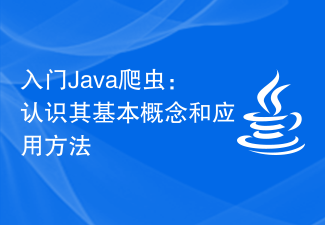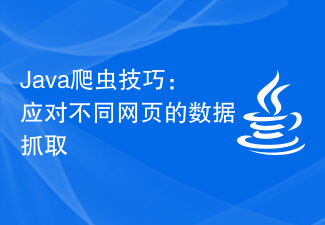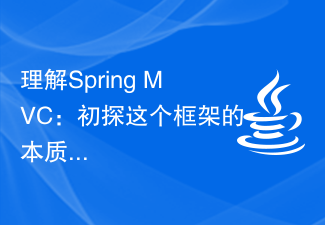 Java
Java javaTutorial
javaTutorial Getting started with Java crawlers: Understand its basic concepts and application methods
Getting started with Java crawlers: Understand its basic concepts and application methods
A preliminary study on Java crawlers: To understand its basic concepts and uses, specific code examples are needed
With the rapid development of the Internet, acquiring and processing large amounts of data has become an important task for enterprises and A task that is indispensable to the individual. As an automated data acquisition method, crawlers (Web Scraping) can not only quickly collect data on the Internet, but also analyze and process large amounts of data. Crawlers have become a very important tool in many data mining and information retrieval projects. This article will introduce the basic concepts and uses of Java crawlers and provide some specific code examples.
- Basic concept of crawler
A crawler is an automatic program that simulates browser behavior to access specified web pages and crawl the information therein. It can automatically traverse web links, obtain data, and store the required data in a local or other database. A crawler usually consists of the following four components:
1.1 Web page downloader (Downloader)
The web page downloader is responsible for downloading web page content from the specified URL. It usually simulates browser behavior, sends HTTP requests, receives server responses, and saves the response content as a web page document.
1.2 Web page parser (Parser)
The web page parser is responsible for parsing the downloaded web page content and extracting the required data. It can extract page content through regular expressions, XPath or CSS selectors.
1.3 Data Storage (Storage)
The data storage is responsible for storing the obtained data, and can save the data to a local file or database. Common data storage methods include text files, CSV files, MySQL databases, etc.
1.4 Scheduler (Scheduler)
The scheduler is responsible for managing the crawler's task queue, determining the web page links that need to be crawled, and sending them to the downloader for downloading. It can perform operations such as task scheduling, deduplication and priority sorting.
- Uses of crawlers
Crawlers can be used in many fields. Here are some common usage scenarios:
2.1 Data collection and analysis
Crawlers can help Enterprises or individuals quickly collect large amounts of data and perform further data analysis and processing. For example, by crawling product information, you can conduct price monitoring or competitor analysis; by crawling news articles, you can conduct public opinion monitoring or event analysis.
2.2 Search Engine Optimization
Crawler is the basis of search engine. Search engine obtains web content from the Internet through crawler and indexes it into the search engine database. When a user searches, the search engine searches based on the index and provides relevant web page results.
2.3 Resource Monitoring and Management
Crawlers can be used to monitor the status and changes of network resources. For example, companies can use crawlers to monitor changes in competitors' websites or monitor the health of servers.
- Java crawler code example
The following is a simple Java crawler code example, used to crawl the information of the Top 250 Douban movies and save it to a local CSV file.
import org.jsoup.Jsoup;
import org.jsoup.nodes.Document;
import org.jsoup.nodes.Element;
import org.jsoup.select.Elements;
import java.io.BufferedWriter;
import java.io.FileWriter;
import java.io.IOException;
public class Spider {
public static void main(String[] args) {
try {
// 创建一个CSV文件用于保存数据
BufferedWriter writer = new BufferedWriter(new FileWriter("top250.csv"));
// 写入表头
writer.write("电影名称,豆瓣评分,导演,主演
");
// 爬取前10页的电影信息
for (int page = 0; page < 10; page++) {
String url = "https://movie.douban.com/top250?start=" + (page * 25);
Document doc = Jsoup.connect(url).get();
// 解析电影列表
Elements elements = doc.select("ol.grid_view li");
for (Element element : elements) {
// 获取电影名称
String title = element.select(".title").text();
// 获取豆瓣评分
String rating = element.select(".rating_num").text();
// 获取导演和主演
String info = element.select(".bd p").get(0).text();
// 将数据写入CSV文件
writer.write(title + "," + rating + "," + info + "
");
}
}
// 关闭文件
writer.close();
} catch (IOException e) {
e.printStackTrace();
}
}
}The above code uses the Jsoup library to obtain the web page content and uses CSS selectors to extract the required data. By traversing the movie list on each page, and saving the movie name, Douban rating, director and starring information into a CSV file.
Summary
This article introduces the basic concepts and uses of Java crawlers and provides a specific code example. Through in-depth study of crawler technology, we can obtain and process data on the Internet more efficiently and provide reliable solutions to the data needs of enterprises and individuals. I hope that readers will have a preliminary understanding of Java crawlers through the introduction and sample code of this article, and can apply crawler technology in actual projects.
The above is the detailed content of Getting started with Java crawlers: Understand its basic concepts and application methods. For more information, please follow other related articles on the PHP Chinese website!
 入门Java爬虫:认识其基本概念和应用方法Jan 10, 2024 pm 07:42 PM
入门Java爬虫:认识其基本概念和应用方法Jan 10, 2024 pm 07:42 PMJava爬虫初探:了解它的基本概念与用途,需要具体代码示例随着互联网的快速发展,获取并处理大量的数据成为企业和个人不可或缺的一项任务。而爬虫(WebScraping)作为一种自动化的数据获取方法,不仅能够快速地收集互联网上的数据,还能够对大量的数据进行分析和处理。在许多数据挖掘和信息检索项目中,爬虫已经成为一种非常重要的工具。本文将介绍Java爬虫的基本概
 Java爬虫技巧:应对不同网页的数据抓取Jan 09, 2024 pm 12:14 PM
Java爬虫技巧:应对不同网页的数据抓取Jan 09, 2024 pm 12:14 PM提升爬虫技能:Java爬虫如何应对不同网页的数据抓取,需要具体代码示例摘要:随着互联网的快速发展和大数据时代的到来,数据抓取变得越来越重要。Java作为一种强大的编程语言,其爬虫技术也备受关注。本文将介绍Java爬虫在处理不同网页数据抓取方面的技巧,并提供具体的代码示例,以帮助读者提升爬虫技能。引言随着互联网的普及,我们可以轻松地获得海量的数据。然而,这些数
 学会使用5个常用的Java工作流框架的基本概念和用法:从入门到精通Dec 27, 2023 pm 12:26 PM
学会使用5个常用的Java工作流框架的基本概念和用法:从入门到精通Dec 27, 2023 pm 12:26 PM从零开始:掌握5个Java工作流框架的基本概念与用法引言在软件开发领域,工作流是一种重要的概念,用于描述和管理复杂的业务流程。Java作为一种广泛应用的编程语言,也有许多优秀的工作流框架供开发者选择。本文将介绍5个Java工作流框架的基本概念与用法,帮助读者快速上手。一、ActivitiActiviti是一个开源的BPM(BusinessProcessM
 Java爬虫技术的原理:详细剖析网页数据抓取过程Jan 09, 2024 pm 02:46 PM
Java爬虫技术的原理:详细剖析网页数据抓取过程Jan 09, 2024 pm 02:46 PM深入解析Java爬虫技术:网页数据抓取的实现原理引言:随着互联网的快速发展和信息爆炸式增长,大量的数据被存储在各种网页上。这些网页数据对于我们进行信息提取、数据分析和业务发展非常重要。而Java爬虫技术则是一种常用的网页数据抓取方式。本文将深入解析Java爬虫技术的实现原理,并提供具体的代码示例。一、什么是爬虫技术爬虫技术(WebCrawling)又称为网
 掌握高效的数据爬取技术:构建强大的Java爬虫Jan 10, 2024 pm 02:42 PM
掌握高效的数据爬取技术:构建强大的Java爬虫Jan 10, 2024 pm 02:42 PM构建强大的Java爬虫:掌握这些技术,实现高效数据爬取,需要具体代码示例一、引言随着互联网的快速发展和数据资源的丰富,越来越多的应用场景需要从网页中抓取数据。而Java作为一门强大的编程语言,自带的网络爬虫开发框架以及丰富的第三方库,使得它成为一个理想的选择。在本文中,我们将介绍如何使用Java构建强大的网络爬虫,并提供具体的代码示例。二、网络爬虫基础知识什
 Go语言中SQL的基本概念及用法解析Mar 27, 2024 pm 05:30 PM
Go语言中SQL的基本概念及用法解析Mar 27, 2024 pm 05:30 PMGo语言中SQL的基本概念及用法解析SQL(StructuredQueryLanguage)是一种专门用来管理和操作关系数据库的语言。在Go语言中,我们通常使用SQL来执行数据库操作,例如查询数据、插入数据、更新数据和删除数据等。本文将介绍Go语言中SQL的基本概念及用法,并附带具体的代码示例。1.连接数据库在Go语言中,我们可以使用第三方库来连接数据
 理解Spring MVC:初探这个框架的本质Dec 29, 2023 pm 04:27 PM
理解Spring MVC:初探这个框架的本质Dec 29, 2023 pm 04:27 PM理解SpringMVC:初探这个框架的本质,需要具体代码示例引言:SpringMVC是一种基于Java的Web应用开发框架,它采用了MVC(Model-View-Controller)的设计模式,提供了一种灵活、可扩展的方式来构建Web应用程序。本文将介绍SpringMVC框架的基本工作原理和核心组件,并结合实际代码示例来帮助读者更好地理解这个框架的本
 使用Java编写网络爬虫:构建个人数据收集器的实用指南Jan 05, 2024 pm 04:20 PM
使用Java编写网络爬虫:构建个人数据收集器的实用指南Jan 05, 2024 pm 04:20 PM构建自己的数据收集器:使用Java爬虫抓取网页数据的实践指南引言:在当今信息时代,数据是一种重要的资源,对于许多应用和决策过程至关重要。而互联网上蕴含着海量的数据,对于需要收集、分析和利用这些数据的人们来说,构建一个自己的数据收集器是非常关键的一步。本文将指导读者通过使用Java语言编写爬虫,实现抓取网页数据的过程,并提供具体的代码示例。一、了解爬虫的原理爬


Hot AI Tools

Undresser.AI Undress
AI-powered app for creating realistic nude photos

AI Clothes Remover
Online AI tool for removing clothes from photos.

Undress AI Tool
Undress images for free

Clothoff.io
AI clothes remover

AI Hentai Generator
Generate AI Hentai for free.

Hot Article

Hot Tools

MinGW - Minimalist GNU for Windows
This project is in the process of being migrated to osdn.net/projects/mingw, you can continue to follow us there. MinGW: A native Windows port of the GNU Compiler Collection (GCC), freely distributable import libraries and header files for building native Windows applications; includes extensions to the MSVC runtime to support C99 functionality. All MinGW software can run on 64-bit Windows platforms.

mPDF
mPDF is a PHP library that can generate PDF files from UTF-8 encoded HTML. The original author, Ian Back, wrote mPDF to output PDF files "on the fly" from his website and handle different languages. It is slower than original scripts like HTML2FPDF and produces larger files when using Unicode fonts, but supports CSS styles etc. and has a lot of enhancements. Supports almost all languages, including RTL (Arabic and Hebrew) and CJK (Chinese, Japanese and Korean). Supports nested block-level elements (such as P, DIV),

WebStorm Mac version
Useful JavaScript development tools

Atom editor mac version download
The most popular open source editor

ZendStudio 13.5.1 Mac
Powerful PHP integrated development environment





